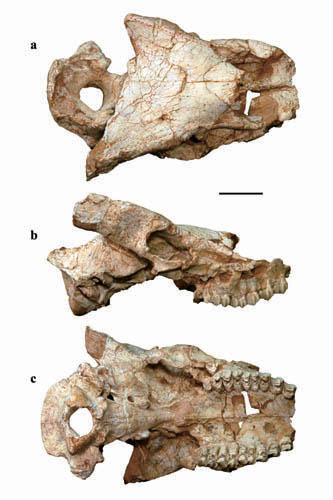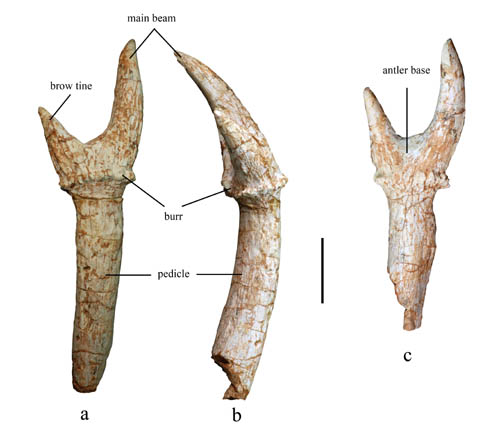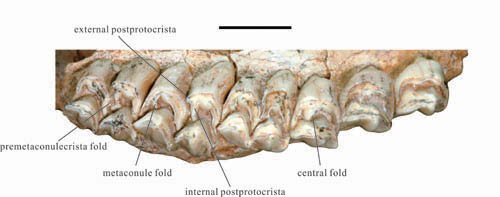The Largest Known Muntiacine Found in China
Dr. HOU Sukuan from the Institute of Vertebrate Paleontology and Paleoanthropology (IVPP), Chinese Academy of Sciences reported a new species of muntiacine Euprox in the journal of Zootaxa 3911 (1) recently. The new species, Euprox grandis sp. nov., is established based on a skull and a pair of antlers from the same individual and a pair of isolated antlers collected from the Late Miocene Liushu Formation of the Linxia Basin in Gansu Province, northwestern China. It is the largest known muntiacine.
Euprox was established by Stehlin (1928) during his study on the cervids from Steinheim in Germany. Previously, several species of Euprox were reported in China, which were usually rare or fragmentary, without associated skull and antlers. Euprox is also rare in the Linxia Basin. Fortunately, a skull and a pair of antlers from the same individual were collected from the Linxia Basin. The antlers, though broken at the insertion of the pedicle, preserve a clear fracture surface on the left antler pedicle, which matches the fracture on the skull exactly, indicating the antlers belong to the same individual as the skull. Therefore, the exact position and direction of the antlers can be observed and the accurate length of the pedicle can be measured.
The new species Euprox grandis is the largest known muntiacine. The skull length is about twice that of Muntiacus reevesi, and 150% of M. muntjak; and the cheek teeth about 115-120% of E. robustus. The pedicle is notably long and robust, and there is a weak burr and a short antler base; the main beam and the brow tine are slightly curved both medially and backwards, and the apex of the main beam turns, curving slightly laterally; the main beam is thinner and shorter than the pedicle, and the brow tine is about 60–70% as long as the main beam; the upper cheek teeth are brachydont, with a clear central fold on the premolars and internal postprotocrista and metaconule fold on M1-M2.
In research on antlered deer, one of the most problematical considerations is the separation of the skull and antler, and usually antlers, isolated teeth and postcranial material are found separately. At the initial phase of the antler evolution, the structures of the antler, for instance, the position and direction of the antler, the presence or absence of the burr, the length and cross section of the antler base, and the direction of the main beam and the brow tine etc., vary greatly in different lineages. Therefore, the classification of many genera, which were erected mainly on antlers, turns out to be very problematic, and the phylogeny of the early antlered deer has been poorly understood. In order to test the phylogenetic relationship of Euprox grandis among muntacines and some basal cervids, a cladistic analysis was carried out. As the strict consensus tree shows E. grandis appears to be an advanced muntiacine form, which may have a close relationship with the genus Muntiacus.
This work was supported by the National Natural Science Foundation of China, the Strategic Priority Research Program of the Chinese Academy of Sciences, the State Key Laboratory of Palaeobiology and Stratigraphy (Nanjing Institute of Geology and Palaeontology, CAS), the Ministry of Science and Technology of China, and the Key Deployment Project of Institute of Vertebrate Paleontology and Paleoanthropology, Chinese Academy of Sciences.

Figure1 Cranial of Euprox grandis sp.nov. from the Linxia Basin, Gansu, China. Holotype. (Image by HOU Sukuan)

Figure 2 Antlers of Euprox grandis sp.nov. from the Linxia Basin, Gansu, China. Holotype. (Image by HOU Sukuan)

Figure 3 Dentition of Euprox grandis sp.nov. from the Linxia Basin, Gansu, China. Holotype. (Image by HOU Sukuan)
Download attachments: